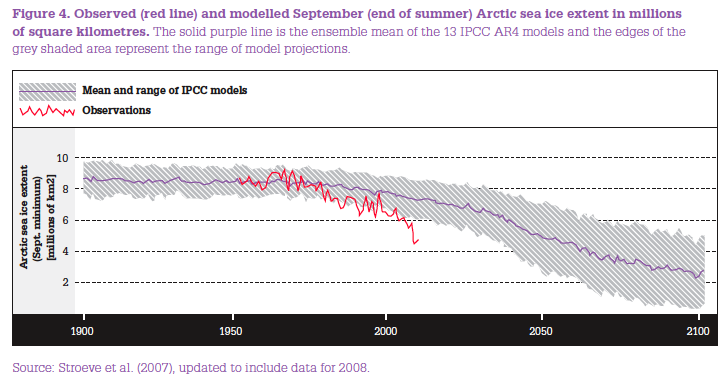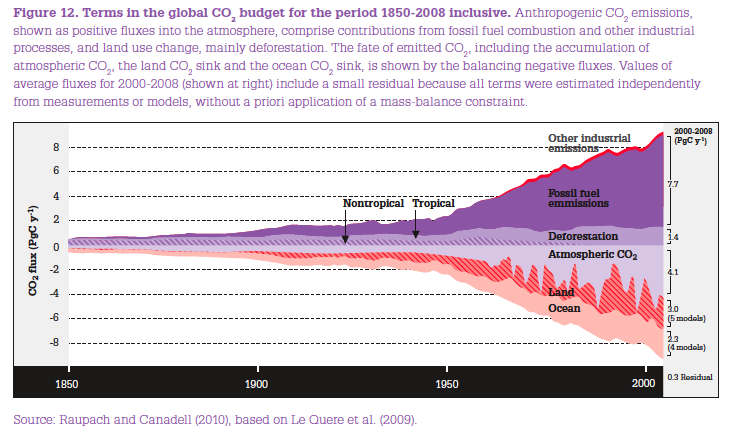
The Australian government established a Climate Commission which recently released a three chapter report entitled The Critical Decade. The first chapter of the report, which we will examine in this post, summarizes the current state of climate science observational data. But first, a statement in the introduction is worth quoting:
"Over the past two or three years, the science of climate change has become a more widely contested issue in the public and political spheres. Climate science is now being debated outside of the normal discussion and debate that occurs within the peer-reviewed scientific literature in the normal course of research. It is being attacked in the media by many with no credentials in the field. The questioning of the Intergovernmental Panel on Climate Change (IPCC), the “climategate” incident based on hacked emails in the UK, and attempts to intimidate climate scientists have added to the confusion in the public about the veracity of climate science."
We at Skeptical Science have documented many such attacks on climate science by individuals with no climate credentials, who misrepresent scientific research, and attempt to sow doubt in the minds of the general public through non-scientific issues like Climategate. But while these introductory comments are worth highlighting, let's move on to the scientific content.
The report is based on the IPCC Fourth Assessment Report (2007) as well as several other more recent studies. Skeptical Science readers will already be familiar with much of the information in the first chapter, but it nevertheless provides a useful summary of recent climate research. The main conclusions of Chapter 1 are as follows:
The report notes that the past decade (2001-2010) was the hottest on record, 0.46°C above the 1961-1990 average. It also contains many illuminating figures, including this one showing that Arctic sea ice is declining far faster than IPCC models projected, currently approximately 40 years ahead of schedule.

The report also discusses that sea level rise is progressing at the very high end of the IPCC estimates, despite the efforts of certain "skeptics" to downplay the sea level rise acceleration based on one exceptionally flawed paper.
Chapter 1 proceeds to discuss the various signals of a changing Australian climate in the biosphere, including mammalian migrations to higher elevations, earlier arrival and later departure times of migratory birds, and the increase in bleaching events on the Great Barrier Reef (GBR). There have been eight mass bleaching events on the GBR since 1979 with no known such events prior to that date. The report goes on to discuss the potential causes of the observed climate change:
Again, this is not news to Skeptical Science readers, nor are the anthropogenic warming fingerprints the report discusses. The ensuing discussion of climate sensitivity is fairly interesting, and harkens back to our examination of the cloud feedback:
"An analysis of the transition of the Earth from the last ice age to the Holocene, which infers climate sensitivity from the observed change in temperature and the corresponding changes in the factors that influence radiative forcing, also estimates a value of about 3°C (Hansen et al. 2008). Much of the uncertainty on the magnitude of climate sensitivity is associated with the direction and strength of cloud feedbacks. Recent observational evidence from short-term variations in clouds suggests that short-term cloud feedbacks are positive, reinforcing the warming, consistent with the current model-based estimates of cloud feedbacks (Clement et al. 2009; Dessler 2010).
A recent model study comparing the relative importance of various greenhouse gases for the climate estimates a sensitivity of approximately 4°C for a doubling of CO2 (Lacis et al. 2010). In addition, the study points to the importance of CO2 as the principal “control knob” governing Earth’s surface temperature."
It's worth noting that while Hansen et al. find paleoclimate evidence for a short-term climate sensitivity of 3°C for doubled atmospheric CO2, they also find that when including slow-acting feedbacks, the long-term sensitivity is closer to 6°C. Next up is a discussion of how the carbon cycle is changing:
There is evidence that the efficiency of natural carbon sinks is declining, particularly in the Southern Ocean, but this possibility remains highly uncertain and controversial. Thus far natural carbon sinks have kept pace with us, absorbing approximately 57% of human emissions since 1958, but there is of course a limit to their storage capacity.

As the planet continues to warm, approaching the 2°C danger limit, not only is there an increasing risk that these natural carbon sinks will become saturated, but potentially significant releases from other carbon sources (methane beneath permafrost, methane hydrates stored under the sea floor, organic material stored in tropical peat bogs, etc.) becomes increasingly likely.
The final section in Chapter 1 discusses the certainty of our knowledge of climate change:
The report notes that some significant uncertainties remain, such as the exact responses of the Greenland and Antarctic ice sheets, and the hydrological cycle, to the continuing warming of the planet. But the report also hammers home a key point that we wish "skeptics" would take to heart:
"These uncertainties, however, in no way diminish our confidence in the observation that the Earth is warming and in our assessment that human emissions of greenhouse gases are the primary reason for this warming."
"Despite these seemingly daunting uncertainties, a number of social, economic and environmental impacts can be observed that are consistent with what is anticipated from the current level of climate change. The number and magnitude of climate-related risks will rise considerably as the climate warms towards 2°C above the preindustrial level; and above the 2°C guardrail, the risks may rise dramatically"
In short, despite the uncertainties, the scientific evidence is clear on the main points that humans are causing dangerous global warming. It's also important to note that uncertainties can go either way, and the consequences of climate change are just as likely to be more damaging than we expect as less. Uncertainty is not our friend.
In Parts 2 and 3 we will examine the report's chapters on risks associated with climate change and implications of the science for emissions reductions.
Posted by dana1981 on Saturday, 28 May, 2011
 |
The Skeptical Science website by Skeptical Science is licensed under a Creative Commons Attribution 3.0 Unported License. |